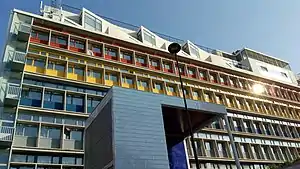| Cité de Refuge | |
|---|---|
 Partial view of the facade, post 1952. | |
| General information | |
| Architectural style | Modernist, International |
| Location | Île-de-France |
| Address | 12 rue Cantagrel, Paris |
| Coordinates | 48°49′36″N 2°22′36″E / 48.826667°N 2.376667°E |
| Current tenants | Salvation Army |
| Construction started | 1929 |
| Completed | 1933 |
| Design and construction | |
| Architect(s) | Le Corbusier |

La Cité de Refuge is a building in Paris, France designed by the architect Le Corbusier.[1][2] It was designed for the Salvation Army and opened in 1933. Since that time it has been occupied by the French Salvation Army.[3] The building, one of Le Corbusier's first urban housing projects,[4] was designated a National Historical Monument of France in 1975.[5]
History
La Cité de Refuge was Le Corbusier's third building for the Salvation Army.[6] It was built between 1929 and 1933 on 12 rue Cantagrel in the 13th arrondissement of Paris.[6][7] The first design meeting occurred in May 1929, and the cornerstone was laid in June 1930.[8]
This was the most ambitious and complex building to be designed and erected by Le Corbusier at this early stage of his career. In order to register for the night, would-be clients of the Salvation Army have to pass through what Kenneth Frampton describes as a "'Still Life' assembly of Platonic forms," which "affords the possibility of a rite of passage."[9]
The building consists of a single long slab block containing cellular accommodation at an angle to Rue de Cantagrel fronted by the free standing sculptural elements containing communal facilities such as reception hall, dining room, and administrative offices.
The facade of the building was problematic from the beginning. It was designed to be a sealed 10,000 sq.ft glass facade with forced air ventilation. The system never worked correctly and was difficult to control. The facade was severely damaged by bombing during World War II.[6] One bomb in particular, dropped August 25, 1944 in front of the building by the Germans, shattered all of its glass facade.[10] Pierre Jeanneret oversaw repairs to the facade, the addition of a brise soleil between 1948 and 1952 and the replacement of the windows to the roof pavilions.[11][12]
The building was partially restored in 1975.[13]

The building underwent extensive renovations beginning in 2007, with the work completed in 2016.[14][15][16][17]
References
- ↑ http://www.fondationlecorbusier.fr/corbuweb/morpheus.aspx?sysId=13&IrisObjectId=4593&sysLanguage=fr-fr&itemPos=4&itemCount=78&sysParentId=64&sysParentName=
- ↑ Deborah Gans; Le Corbusier (2006). The Le Corbusier Guide. Princeton Architectural Press. pp. 41–. ISBN 978-1-56898-539-8.
- ↑ "Présentation : Armée du Salut organisation humanitaire en France". Archived from the original on 2017-03-14. Retrieved 2017-04-18.
- ↑ "Le Corbusier's freshly-restored Paris shelter to open to the public". theartnewspaper.com. Archived from the original on 2016-04-04.
- ↑ Base Mérimée: PA00086591, Ministère français de la Culture. (in French)
- 1 2 3 Jean-Louis Cohen (2004). Le Corbusier, 1887-1965: The Lyricism of Architecture in the Machine Age. Taschen. pp. 51–. ISBN 978-3-8228-3535-7.
- ↑ Deborah Gans (16 May 2014). The Le Corbusier Guide. Elsevier Science. pp. 34–. ISBN 978-1-4831-3577-9.
- ↑ Brian Brace Taylor (22 December 1987). Le Corbusier: The City of Refuge, Paris 1929/33. University of Chicago Press. pp. 21–. ISBN 978-0-226-79134-0.
- ↑ Taylor, Brian Brace (1988). Le Corbusier: The City of Refuge, Paris, 1929-33. London: University of Chicago Press.
- ↑ Nicholas Fox Weber (2008). Le Corbusier: A Life. Alfred A. Knopf. pp. 357–. ISBN 978-0-375-41043-7.
- ↑ Stephen Sennott (1 January 2004). Encyclopedia of Twentieth Century Architecture. Taylor & Francis. pp. 312–. ISBN 978-1-57958-433-7.
- ↑ Franca Trubiano (5 March 2013). Design and Construction of High-Performance Homes: Building Envelopes, Renewable Energies and Integrated Practice. Routledge. pp. 39–. ISBN 978-1-135-87484-1.
- ↑ Dennis J. De Witt; Elizabeth R. De Witt (1987). Modern Architecture in Europe: A Guide to Buildings Since the Industrial Revolution. Penguin Group USA. pp. 154–. ISBN 978-0-525-24415-8.
- ↑ Larrochelle, Jean-Jacques (24 February 2016). "La Cité de refuge, octogénaire au grand cœur". Le Monde.fr – via Le Monde.
- ↑ agence, A. F. P.; lefigaro.fr (23 June 2016). "Un "refuge" signé Le Corbusier réhabilité pour les plus démunis" – via Le Figaro.
- ↑ "Paris : la Cité de Refuge de Le Corbusier a retrouvé son éclat". 18 April 2017.
- ↑ "Le Corbusier's Cité de Refuge in Paris to reopen after restoration".
.jpg.webp)